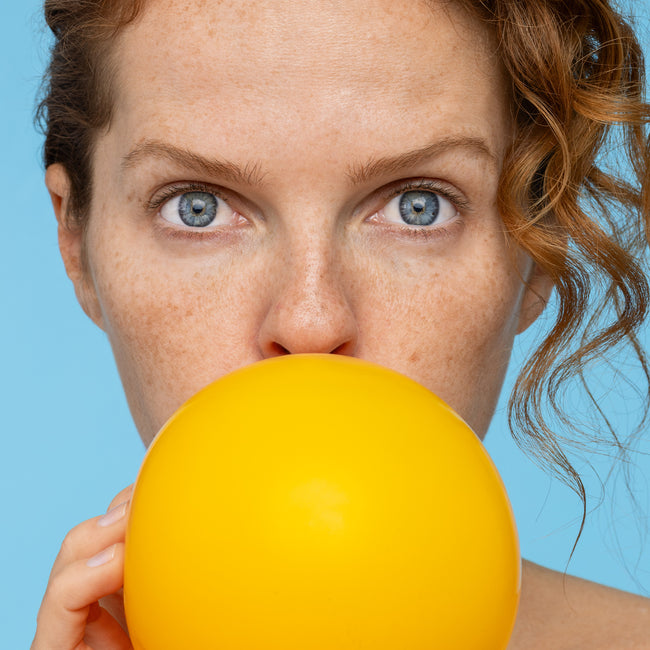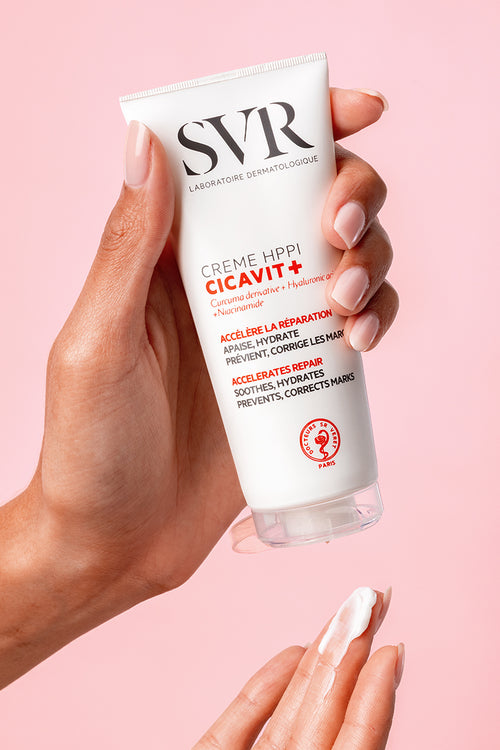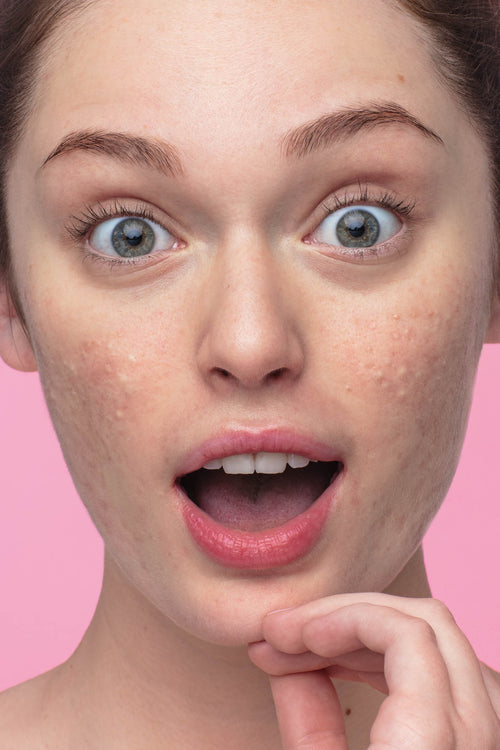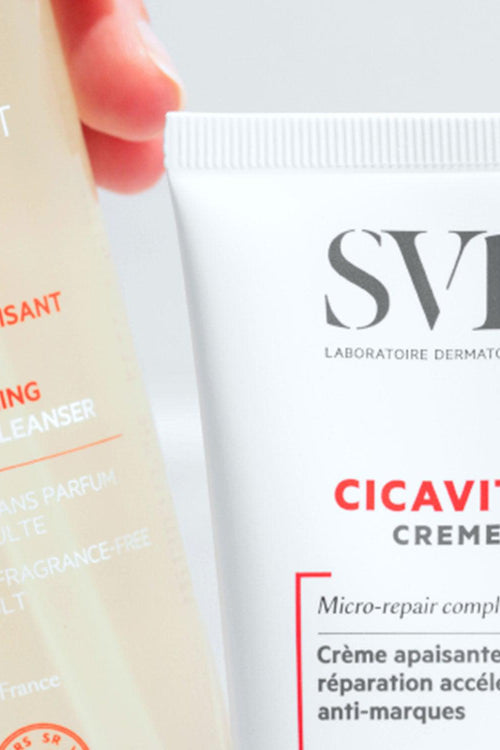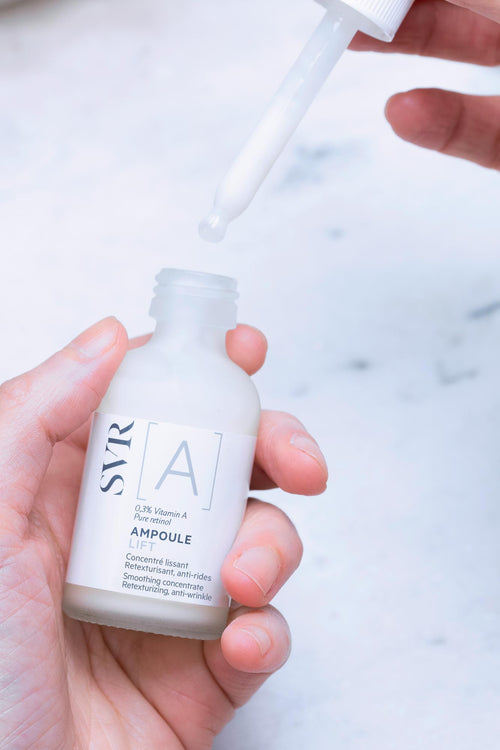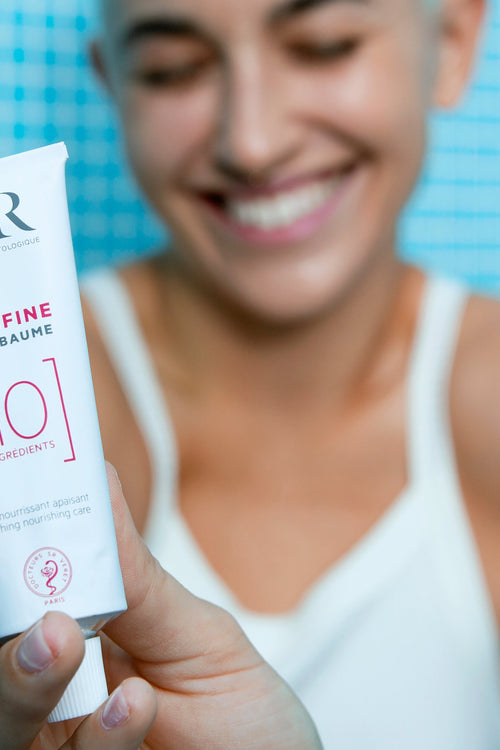

RED PATCHES: ECZEMA OR PSORIASIS?
Red patches, tingling, itching... it's not always easy to know what it is! So how can you tell the difference between atopic eczema and psoriasis? And what can be done to prevent and relieve these skin problems? Here are some answers to help you see
more clearly.
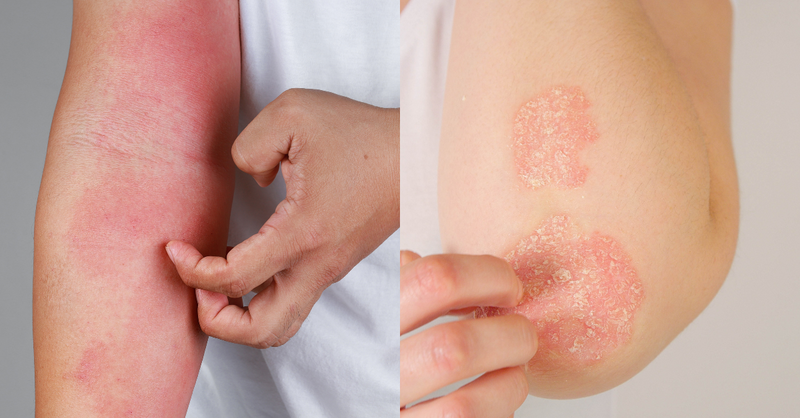
Although eczema and psoriasis share similar symptoms, such as red patches, they manifest themselves in different ways.
Let's find out how to identify them!
During an eczema flare-up, the red patches are asymmetrical and ill-defined. They may be covered with small vesicles (bubbles), sometimes oozing. Typical psoriasis plaques, on the other hand, are oval, well-defined, with a thick crust, red at the edges and white in the center (due to small pearly scales).
The location of eczema lesions varies with age. In babies, they generally appear on bulging areas such as the cheeks, temples, arms and thighs. In children, lesions appear in hollow areas: in the folds of the elbows, behind the knees and on the wrists.
Psoriasis can occur at any age, but appears mainly during adolescence, then around the age of 50 (1) .
It generally appears on bulging areas of the body subject to friction, such as elbows and knees, and is symmetrically distributed on both sides. Eczema lesions are generally painless, but can be intensely itchy, often more so in the evening and at night, disrupting sleep. Psoriasis patches, on the other hand, are less itchy, except for those on the scalp.
So, have you guessed which photo represents eczema and which psoriasis?

- Asymmetrical
- Ill-defined plaques located in a hollow area
- Severe itching
- Symmetrical, oval, well-defined plaques
- Thick, white crusts in the center
- Located in a bulging area
- Mild itching
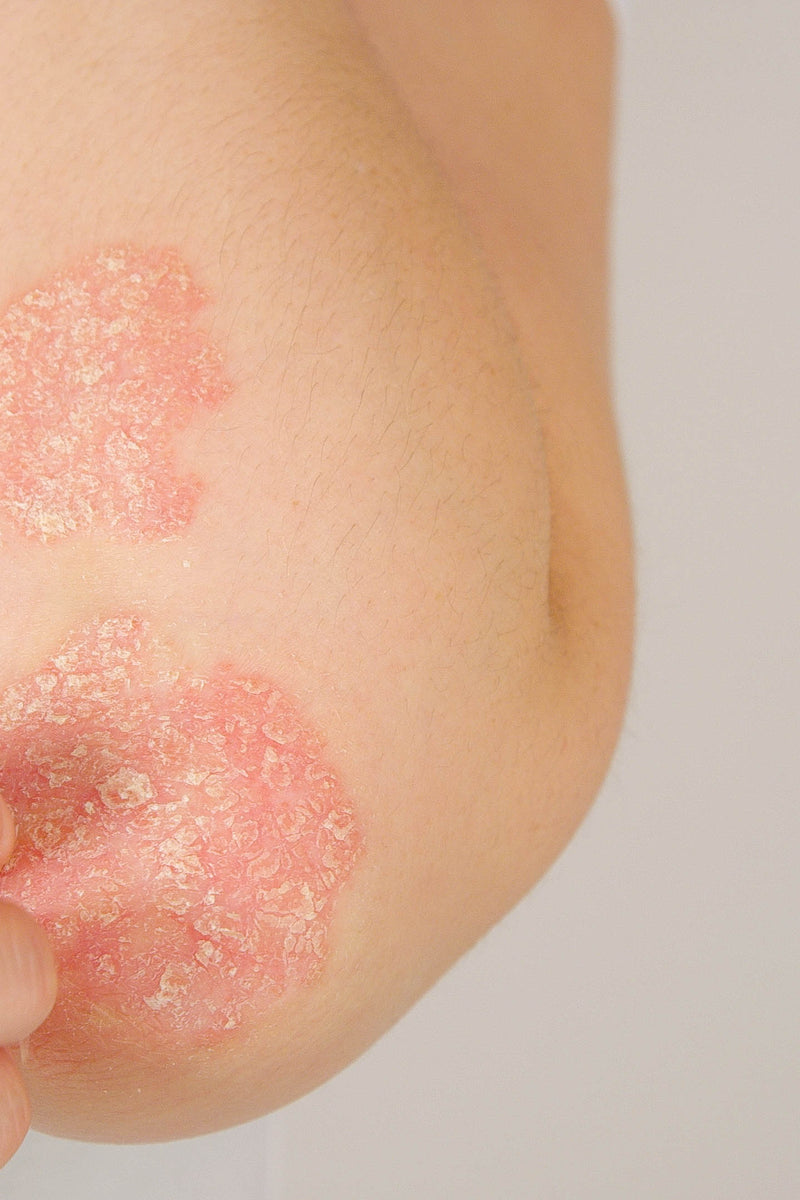
Now that you know the difference between the red patches of eczema and those of psoriasis, let's dive even deeper into the subject: let's talk eczema and let's talk psoriasis.
Atopic eczema (or atopic dermatitis) is a chronic inflammatory skin disease that progresses in flare-ups. The skin is permanently dry (xerosis), and during periods of crisis, red patches appear, associated with intense itching. It's a very common skin disease, more frequent than psoriasis. In France, it affects around 1 in 10 children, and 10-15% of cases persist into adulthood(2).
The causes of atopic dermatitis are manifold, and mainly involve three aspects:
- A genetic background: the probability of developing atopic eczema is increased if there is a family history of the condition. The skin of sufferers is porous, water escapes (the skin becomes dry) and multiple irritant substances penetrate (triggering an inflammatory reaction and the appearance of the famous characteristic red patches).
- An anomaly in the cutaneous barrier: the skin of sufferers is porous, water escapes (the skin becomes dry) and multiple irritant substances penetrate (triggering an inflammatory reaction and the appearance of the famous characteristic red patches).
- An inappropriate immune response: the immune cells responsible for allergic reactions are hyperactive in atopic people.
Other factors can also aggravate it, such as scratching, creating a veritable vicious circle: the more you scratch, the thicker your skin becomes, and the more you want to scratch. There's also the external environment, such as pollution or dust mites, which can also make matters worse.
Note: We need to differentiate between atopic eczema (where the skin barrier is altered) and contact eczema (where the skin barrier is not altered). Contact eczema is allergic eczema: it appears when the skin comes into contact with a trigger (the allergen), causing red patches at the site of contact.
Identifying and eliminating the allergen stops the eczema: the red patches disappear.
(2) Atopic dermatitis (atopic eczema) - Inserm, La science pour la santé

What are the treatments ?
Although atopic dermatitis cannot be completely eradicated, there are ways of alleviating the condition and improving quality of life for sufferers. It's important to understand that treatment is based on three pillars: basic treatment, crisis treatment and advice for day-to-day use.
Basic treatment, essential for atopic dermatitis, is emollient! This dermo-cosmetic product moisturizes, nourishes and restores the damaged skin barrier by providing ceramides. Applied daily, it prevents water loss and the entry of irritants, instantly soothing and relieving the skin.
Crisis treatment relies mainly on anti-inflammatory drugs. As soon as red patches appear, it's important to consult a doctor and follow the prescription carefully. Depending on the severity of the eczema, he or she may prescribe creams (such as dermocorticoids) or other treatments in tablet or injection form (such as corticoids, immunomodulators or biotherapies). Good compliance is the key to rapidly alleviating symptoms!
Here are a few ideas for daily tips to limit the appearance of eczema:
- Take short, lukewarm showers to avoid drying out the skin
- Use gentle, fragrance-free cleansers to minimize irritation (such as cleansing oils or syndet)
- Wear cotton clothing to avoid rubbing and irritation
- Airify rooms in the house to reduce dust and the presence of dust mites
SVR Topialyse Range is the perfect routine for repairing and soothing dry to atopic skin, and preventing eczema attacks.
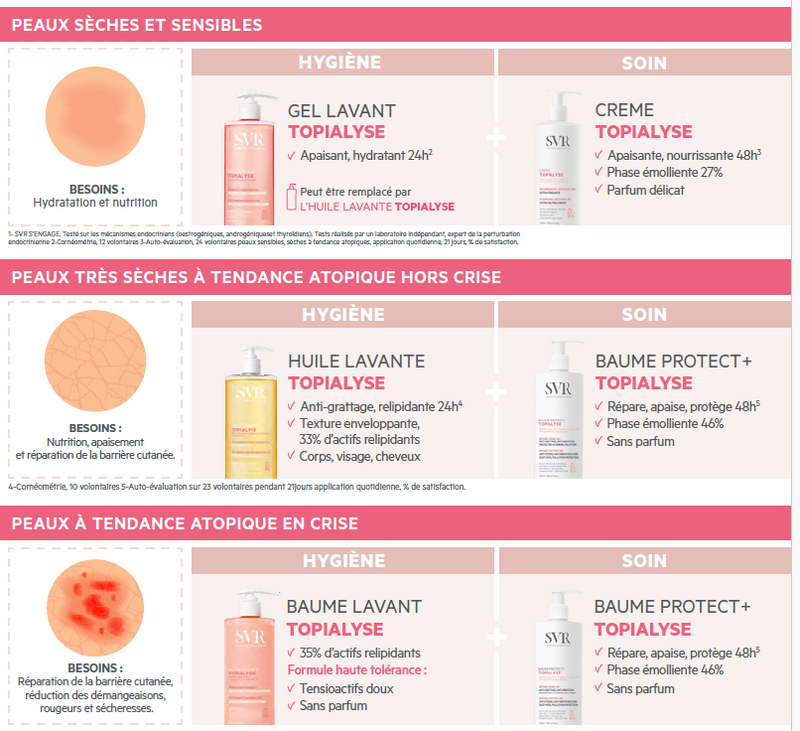
Cleansing Oil
Cleansing Oil
Protect+ Balm
Cleansing Gel
Cleansing Gel
Cream
Psoriasis is a chronic, inflammatory skin disease characterized by red patches covered by a thick, white crust.
It's a common skin disease that can affect anyone, regardless of age or sex, and can cause significant social embarrassment. In France, it affects between 1.5 and 3 million people(3).
Psoriasis is caused by accelerated renewal of skin cells. Keratinocytes are renewed in just 4 days, instead of the normal 28. This over-rapid regeneration leads to an accumulation of cells on the surface, responsible for thickening of the skin: this is called hyperkeratosis!
This thickening is accompanied by inflammation self-sustained by scratching and rubbing, making the skin vulnerable to external aggression: it loses its role as a protective barrier. The environment also influences psoriasis: it often improves in summer and worsens in winter, while stress or certain medications (ask your doctor or pharmacist for more information) can trigger attacks.
What are the treatments ?
Although psoriasis cannot be completely eradicated, there are solutions that can considerably reduce symptoms and improve quality of life.
Basic treatment consists of using a moisturizing cream containing a keratolytic ingredient, such as urea, to gently soften and exfoliate the skin. Daily application prevents the build-up of dead skin cells and keeps the skin well hydrated.
Crisis treatment is based on different therapeutic strategies, depending on severity and impact on quality of life. As with eczema, it's important to consult ad octor and follow the prescription carefully. Depending on the perceived discomfort and resistance of psoriasis plaques, he or she may prescribe creams (such as dermocorticoids) or other treatments such as phototherapy or immunosuppressants. It can never be said often enough: adhering to your prescription is the key!
A few simple, everyday gestures can help limit the appearance of psoriasis plaques - a disease that needs to be treated gently! We recommend :
- Take short, lukewarm showers
- Dry your skin by patting with a soft towel
- Expose yourself moderately to the sun
DM Psoriasis
Laboratoire SVR has developed a medical device to treat the symptoms of psoriasis: plaques, scales, itching and redness.
Thanks to its targeted, keratolytic action, it reduces scaly patches and eliminates the thickness of red, hardened areas, for smoother, soothed skin. Its intensely moisturizing formula relieves itching while reducing redness. Discover Xerial DM Psoriasis!
- Sources
Dr.Gresset-Chaussade, entretien sur l’eczéma atopique - Dr.Dubois, entretien sur le psoriasis
- Pr. Tennstedt, entretien sur le psoriasis
- Les crèmes et les traitements locaux pour l'eczéma, Fondation Eczéma
- Utilisation des dermocorticoïdes au cours de la dermatite atopique de l’enfant F. CAMBAZARD Ann Dermatol Venereol 2005;132:1S64-7
- Dermatite atopique (Eczéma) -
symptômes, causes, traitements et prévention - VIDAL - Eczéma ou dermatite atopique :
causes, symptômes et évolution | ameli.fr - Psoriasis - symptômes, causes,
traitements et prévention - VIDAL - Comprendre le psoriasis | ameli.fr




